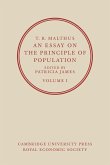Thomas Paine
Rights of Man. Part the Second. Combining Principle and Practice
Thomas Paine
Rights of Man. Part the Second. Combining Principle and Practice
- Broschiertes Buch
- Merkliste
- Auf die Merkliste
- Bewerten Bewerten
- Teilen
- Produkt teilen
- Produkterinnerung
- Produkterinnerung
First published in 1792, the continuation of Paine's Rights of Man develops concrete measures for political reform.
Andere Kunden interessierten sich auch für
![An Essay on the Principle of Population An Essay on the Principle of Population]() Thomas Robert MalthusAn Essay on the Principle of Population47,99 €
Thomas Robert MalthusAn Essay on the Principle of Population47,99 €![An Essay on the Principle of Population An Essay on the Principle of Population]() Thomas MalthusAn Essay on the Principle of Population17,99 €
Thomas MalthusAn Essay on the Principle of Population17,99 €![Change!: Combining Analytic Approaches with Street Wisdom Change!: Combining Analytic Approaches with Street Wisdom]() Change!: Combining Analytic Approaches with Street Wisdom32,99 €
Change!: Combining Analytic Approaches with Street Wisdom32,99 €![A Vindication of the Rights of Men A Vindication of the Rights of Men]() Mary WollstonecraftA Vindication of the Rights of Men30,99 €
Mary WollstonecraftA Vindication of the Rights of Men30,99 €![The Uses of Literacy in Early Mediaeval Europe The Uses of Literacy in Early Mediaeval Europe]() Rosamond McKitterick (ed.)The Uses of Literacy in Early Mediaeval Europe63,99 €
Rosamond McKitterick (ed.)The Uses of Literacy in Early Mediaeval Europe63,99 €![Classical Culture and the Idea of Rome in Eighteenth-Century England Classical Culture and the Idea of Rome in Eighteenth-Century England]() Philip AyresClassical Culture and the Idea of Rome in Eighteenth-Century England37,99 €
Philip AyresClassical Culture and the Idea of Rome in Eighteenth-Century England37,99 €![The Other World The Other World]() Janet OppenheimThe Other World69,99 €
Janet OppenheimThe Other World69,99 €-
-
-
First published in 1792, the continuation of Paine's Rights of Man develops concrete measures for political reform.
Hinweis: Dieser Artikel kann nur an eine deutsche Lieferadresse ausgeliefert werden.
Hinweis: Dieser Artikel kann nur an eine deutsche Lieferadresse ausgeliefert werden.
Produktdetails
- Produktdetails
- Verlag: Cambridge University Press
- Seitenzahl: 198
- Erscheinungstermin: 24. Februar 2012
- Englisch
- Abmessung: 216mm x 140mm x 11mm
- Gewicht: 257g
- ISBN-13: 9781108045469
- ISBN-10: 1108045464
- Artikelnr.: 35281589
- Herstellerkennzeichnung
- Libri GmbH
- Europaallee 1
- 36244 Bad Hersfeld
- gpsr@libri.de
- Verlag: Cambridge University Press
- Seitenzahl: 198
- Erscheinungstermin: 24. Februar 2012
- Englisch
- Abmessung: 216mm x 140mm x 11mm
- Gewicht: 257g
- ISBN-13: 9781108045469
- ISBN-10: 1108045464
- Artikelnr.: 35281589
- Herstellerkennzeichnung
- Libri GmbH
- Europaallee 1
- 36244 Bad Hersfeld
- gpsr@libri.de
Common SenseThomas Paine1776 Common Sense is a pamphlet written by Thomas Paine in 1775-1776 advocating independence from Great Britain to people in the Thirteen Colonies. Writing in clear and persuasive prose, Paine marshaled moral and political arguments to encourage common people in the Colonies to fight for egalitarian government. It was published anonymously on January 10, 1776, at the beginning of the American Revolution, and became an immediate sensation.It was sold and distributed widely and read aloud at taverns and meeting places. In proportion to the population of the colonies at that time (2.5 million), it had the largest sale and circulation of any book published in American history. As of 2006, it remains the all-time best-selling American title and is still in print today.Common Sense made public a persuasive and impassioned case for independence, which had not yet been given serious intellectual consideration. Paine connected independence with common dissenting Protestant beliefs as a means to present a distinctly American political identity and structured Common Sense as if it were a sermon. Historian Gordon S. Wood described Common Sense as "the most incendiary and popular pamphlet of the entire revolutionary era."The text was translated into French by Antoine Gilbert Griffet de Labaume in 1790.Paine arrived in the American colonies in November 1774, shortly before the Battles of Lexington and Concord. Though the colonies and Great Britain had commenced hostilities against one another, the thought of independence was not initially entertained. Writing of his early experiences in the colonies in 1778, Paine "found the disposition of the people such, that they might have been led by a thread and governed by a reed. Their attachment to Britain was obstinate, and it was, at that time, a kind of treason to speak against it. Their ideas of grievance operated without resentment, and their single object was reconciliation." Paine quickly engrained himself in the Philadelphia newspaper business, and began writing Common Sense in late 1775 under the working title of Plain Truth. Though it began as a series of letters to be published in various Philadelphia papers, it grew too long and unwieldy to publish as letters, leading Paine to select the pamphlet form.Benjamin Rush recommended the publisher Robert Bell, promising Paine that although other printers might balk at the content of the pamphlet, Bell would not hesitate or delay its printing.
To M de la Fayette
Preface
Introduction
1. Of society and civilization
2. Of the origin of the present old government
3. Of the new and old systems of government
4. Of constitutions
5. Ways and means of reforming the political condition of Europe, interspersed with miscellaneous observations
Appendix.
Preface
Introduction
1. Of society and civilization
2. Of the origin of the present old government
3. Of the new and old systems of government
4. Of constitutions
5. Ways and means of reforming the political condition of Europe, interspersed with miscellaneous observations
Appendix.
To M de la Fayette
Preface
Introduction
1. Of society and civilization
2. Of the origin of the present old government
3. Of the new and old systems of government
4. Of constitutions
5. Ways and means of reforming the political condition of Europe, interspersed with miscellaneous observations
Appendix.
Preface
Introduction
1. Of society and civilization
2. Of the origin of the present old government
3. Of the new and old systems of government
4. Of constitutions
5. Ways and means of reforming the political condition of Europe, interspersed with miscellaneous observations
Appendix.








